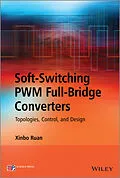Soft-switching PWM full-bridge converters have been widely used in medium-to-high power DC-DC conversions for topological simplicity, easy control and high effi ciency. Early works on soft-switching PWM full-bridge converter by many researchers included various topologies and modulation strategies. However, these works were scattered, and the relationship among these topologies and modulation strategies had not been revealed. This book intends to describe systematically the soft-switching techniques for pulse-width modulation (PWM) full-bridge converters, including the topologies, control and design, and it reveals the relationship among the various topologies and PWM strategies previously proposed by other researchers. The book not only presents theoretical analysis, but also gives many detailed design examples of the converters.
* Describes the soft-switching techniques for pulse-width modulation (PWM) full-bridge
converters systematically
* Covers topologies, control and design, from the basics, through to applications and
development
* Deliberates the soft-switching PMW control technique rather than the standard PWM
control technique
* Presents detailed theoretical analysis with design examples for various possible
variations to the full-bridge topology using the soft-switching technique
Soft-Switching PWM Full-Bridge Converters: Topologies, Control, and Design is an essential and valuable reference for graduate students and academics majoring in power electronics and power supply design engineers. Senior undergraduate students majoring in electrical engineering and automation engineering would also fi nd this book useful.
Autorentext
Xinbo Ruan, Nanjing University of Aeronautics and Astronautics, China.
Inhalt
About the Author xi
Preface xiii
Acknowledgment xvii
List of Abbreviations xix
1 Topologies and Operating Principles of Basic Full-Bridge Converters 1
1.1 Introduction 1
1.1.1 Development Trends in Power Electronics Technology 1
1.1.2 Classification and Requirements of Power Electronics Converters 2
1.1.3 Classification and Characterization of dcdc Converters 3
1.2 Isolated Buck-Derived Converters 4
1.2.1 Forward Converter 4
1.2.2 PushPull Converter 7
1.2.3 Half-Bridge Converter 10
1.2.4 Full-Bridge Converter 11
1.2.5 Comparison of Isolated Buck-Derived Converters 12
1.3 Output Rectifier Circuits 14
1.3.1 Half-Wave Rectifier Circuit 14
1.3.2 Full-Wave Rectifier Circuit 15
1.3.3 Full-Bridge Rectifier Circuit 17
1.3.4 Current-Doubler Rectifier Circuit 18
1.4 Basic Operating Principle of Full-Bridge Converters 21
1.4.1 Topologies of Full-Bridge Converters 21
1.4.2 Pulse-Width Modulation Strategies for Full-Bridge Converters 21
1.4.3 Basic Operating Principle of a Full-Bridge Converter with a Full-Wave Rectifier Circuit and a Full-Bridge Rectifier Circuit 21
1.4.4 Basic Operating Principle of a Full-Bridge Converter with a Current-Doubler Rectifier Circuit 24
1.5 Summary 32
References 32
2 Theoretical Basis of Soft Switching for PWM Full-Bridge Converters 33
2.1 PWM Strategies for Full-Bridge Converters 33
2.1.1 Basic PWM Strategy 33
2.1.2 Definition of On-Time of Power Switches 36
2.1.3 A Family of PWM Strategies 36
2.2 Two Types of PWM Strategy 38
2.2.1 The Two Diagonal Power Switches Turn Off Simultaneously 39
2.2.2 The Two Diagonal Power Switches Turn Off in a Staggered Manner 41
2.3 Classification of Soft-Switching PWM Full-Bridge Converters 43
2.4 Summary 44
Reference 44
3 Zero-Voltage-Switching PWM Full-Bridge Converters 45
3.1 Topologies and Modulation Strategies of ZVS PWM Full-Bridge Converters 45
3.1.1 Modulation of the Lagging Leg 45
3.1.2 Modulation of the Leading Leg 47
3.1.3 Modulation Strategies of the ZVS PWM Full-Bridge Converters 47
3.2 Operating Principle of ZVS PWM Full-Bridge Converter 49
3.3 ZVS Achievement of Leading and Lagging Legs 54
3.3.1 Condition for Achieving ZVS 54
3.3.2 Condition for Achieving ZVS for the Leading Leg 54
3.3.3 Condition for Achieving ZVS for the Lagging Leg 54
3.4 Secondary Duty Cycle Loss 55
3.5 Commutation of the Rectifier Diodes 55
3.5.1 Full-Bridge Rectifier 56
3.5.2 Full-Wave Rectifier 57
3.6 Simplified Design Procedure and Example 59
3.6.1 Turn Ratio of Transformer 59
3.6.2 Resonant Inductor 59
3.6.3 Output Filter Inductor and Capacitor 60
3.6.4 Power Devices 60
3.6.5 Load Range of ZVS 61
3.7 Experimental Verification 62
3.8 Summary 66
References 66
4 Zero-Voltage-Switching PWM Full-Bridge Converters with Auxiliary-Current-Source Networks 67
4.1 Current-Enhancement Principle 68
4.2 Auxiliary Current-Source Network 69
4.3 Operating Principle of a ZVS PWM Full-Bridge Converter with Auxiliary-Current-Source Network 72
4.4 Conditions for Achieving ZVS in the Lagging Leg 78
4.5 Parameter Design 78
4.5.1 Parameter Selection for the Auxiliary-Current-Source Network 79
4.5.2 Determination of Lr, Cr, and Ic 79
4.5.3 Design Example 80
4.6 Secondary Duty Cycle Loss and Selection of Dead Time for the Drive Signals of the Lagging Leg 81
4.6.1 Secondary Duty Cycle Loss 81
4.6.2 Selection of Dead Time between Drive Signals of the Lagging Leg 82
4.6.3 Comparison with Full-Bridge Converter with Saturable Inductor 82
4.7 Experimental Verification 85
4.8 Other Auxiliary Current-Source Networks for ZVS PWM Fu...
